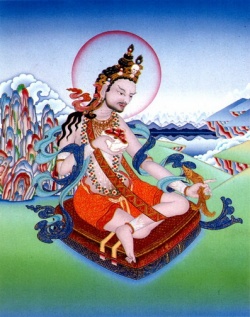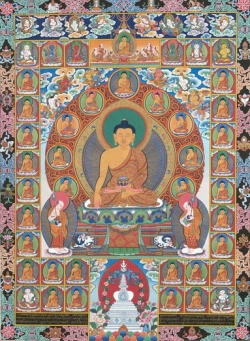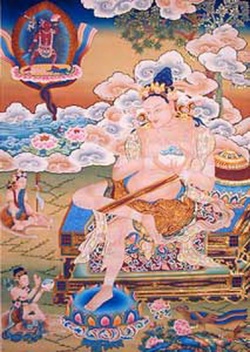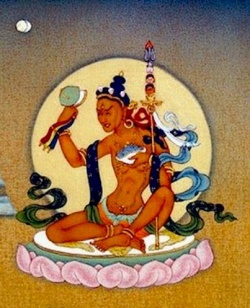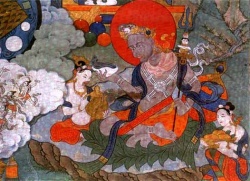The Practice of Visualizing Words
In Heat-Yoga, a teaching of meditating on different words in the three Channels and four Chakras is provided. This teaching is found in both the fundamental Tantra of Hevajra and the Expounding Tantra of Sambhuda.
Many great accomplished yogis, such as the Black Practitioner (Nagbo-Spyod-pa), taught this teaching.
The practice of visualizing words includes two ways—the comprehensive way and the simple.
The comprehensive way is to meditate on the words both at the center of the Chakra and at each different nerve-leaf.
But in this teaching (of the Six Yogas), we find no clear instructions on this.
The simple way is to meditate only on the words in the center of the four Chakras.
This is clearly stated in the Expounding Tantra and the teachings of the great accomplished beings.
Reflecting on this principle, one finds that merely meditating on the small Ah word in the Navel Center and the Hūṃ word in the Head Center is not sufficient nor desirable.
To meditate on the words in the Heart Center and Throat Center is also necessary. It is of great importance.
To meditate on the words, one should follow the aforementioned instructions on keeping posture.
Visualize the small Ah word at the center of the Transformation Chakra of the navel, or in the center in the Central Channel, which is close to the core of the spine. The Yogi should concentrate only at this point.
The visualization procedure is as follows:
Visualize a small red, Sanskrit Ah word. Its shape is similar to the Tibetan word Shad of the printed alphabet, standing upon a moon-wheel.
To locate the visualization in the Heart Center, the yogi should see the word at the center of the eight nerve-leaves of the Dharma Chakra of the Heart Center near the central point between the two breasts..
He should meditate only on the point in the Central Channel that is near the spine.
Visualize a blue Hūṃ word standing on a moon-wheel, head face down, the Bodhi-Heart like snow about to melt.
To locate the visualized word at the Throat Center, the yogi should visualize only the center-point of the sixteen nerve-leaves of the Throat Center in the Central Channel near the spinal column. Visualize at this point a red Oṃ word, its head facing up, standing on the moon-wheel.
To locate the word at the Head Center, the yogi should visualize the word at the center of the nerve-leaves of the Head Center in the Central Channel near the spinal column. Visualize at the point a white Haṃ word, facing down, standing on the moon-wheel.
It is of great importance that the yogi should visualize the points in the center of the Central Channel, entwined by the knot of the Right and Left channels, at the cross sections of the four Chakras.
Says the Expounding Tantra Sambhoda:
"The lotus that reaches the inner part of the heart
Is the principal one, which has eight nerve-leaves.
The nerve that reaches the inside of it is like a lamp.
In shape, it resembles the plantain flower,
Leaves opened and facing downward.
The god who dwells within it
Is as small as the mustard seed.
The indestructible seed—the Hūṃ,
Trembles like the snow about to melt…" [cf. the Upanisadic and the gotra teaching.]
The nerve that reaches the inner part of the heart is the principal nerve, which implies the Central Channel; the Hūṃ
world should be visualized in it. \The other words in the other three Chakras should be visualized as well.
Although there are many different teachings on the word-visualization in the four Chakras, the essential point is to visualize these words in the center of the Central Channel.
Nevertheless, this point is not clearly stated in some teachings. If it is not clearly understood, one will not be able to gather the pranas at the Central Channel; consequently one will miss the essence of the pith-instruction.
The size of the words on which the yogi meditates should be as small as the mustard seed—as the Tantra describes the Hūṃ word. This size applies to the other four words as well.
The smaller and clearer the word as visualized and held by the mind, the easier it is to control the pranas. This is a very important factor in mastering the pranas.
Although the Sambhodra Tantra does not mention it, the small word Ah should be visualized with a head.
According to the pith-instruction given in the Tantra of Bde-mchog, all the four words should be visualized with the half-moon head, the Thig-le and Na-da melting like the female Bodhisattva about to weep.
This teaching is important because it produces and will enhance the Great Bliss.
If the Yogi visualizes the word as very bright and glowing, he will be able easily to overcome drowsiness and promote his illuminating experience of Samadhi.
When any visualized object is meditated upon, the yogi should put all his mind into the subtle object as if his mind (or rather his whole being) enters into the object.
He should never visualize the object as if he merely sees it before him.
For the correct practice, mind and object become as one; thus the experience of the unification of mind and Thig-le will come to pass, and, the gathering of the prana will become easy.
In the practice of this meditation one should neither overstrain nor be too lax in his effort.
Overstrain or laziness will bring drowsiness and distractions; therefore, the yogi should avoid both extremes.
The beginner should not meditate on the three words above the heart center for too long; he should meditate on them for only a short while, and devote most of this time to concentrating on the small Ah.
If he finds it difficult to concentrate on the minute object, he should visualize it a little larger. When a larger picture can be stabilized in the mind, the yogi will then be able to visualize smaller or more subtle objects.
The purpose of practicing the Heat Yoga is to produce the Four Blisses.
When the Bodhi-Heart in the nerves begins melting and the two pranas69 start gathering at the head Chakra, the (first) Bliss [[[ananda]]) begins to arise.
Thereafter, the Bodhi-Heart begins to disperse into the nerves.
When the Bodhi-Heart gathers at the Throat Center the (second) Extreme-Bliss [[[paramananda]]) arises; then the Bodhi-Heart disperses again through the different nerves, and when it is gathered at the Heart Center, the (third) Superb Bliss [viramananda] arises.
Again, the Bodhi-Hearth disperses through the nerves, and when it is gathered at the Navel Center, the (fourth) Innate Bliss [sahajananda] arises *. Following this
if one meditates upon the words in the center of the Central Channel in the four Chakras, the mind-prana will be easily gathered at the four centers; thus, the Four Blisses will arise from the four centers. It is necessary for the Yogi to recognize these Four Blisses in experience.
When the Bodhi-Hearth begins to melt and drop down from the upper center to the lower centers, if the Bodhi-Heart cannot remain at each center for a longer period, it will be extremely difficult for the yogi to recognize the differences between the Four Blisses.
Especially will it be difficult to recognize the Innate Bliss.
Thus one should know that if the mind can concentrate a long period on the four Chakras, the melted Bodhi-Heart will also remain at the different centers for a longer period.
This is a very important point. If the Haṃ word at the Head Center that is the center of the white Bodhi-Heart can be stabilized, the white element will be greatly enhanced and multiplied. If the word at the Throat Center, the place through which
the Right Channel multiplies the blood-element, can be stabilized, the secretion of the Dumo which comes from the Navel Center will produce great power.
Consequently, it will promote and improve the practice of Dream Yoga.
The Heart Center is the center of light.
If the Hūṃ word at the heart center is stabilized the great light will unfold. Meditation on the Heart Center will help the emergence of the light in both the waking and the sleeping states.
The small Ah word should also be stabilized at the Navel Center, since through it the Left Channel multiplies the fluid.
From the Navel Center the White-Bodhi-Heart revitalizes the whole body.
Furthermore, this center is the special place where the Dumo resides.
It is well known that the Navel Center is the place where the fire, that melts the Bodhi-Heart, is kindled. **
It is of great importance that the yogi should acquaint himself with the teaching of the meditation on the Chakras and their words. Until all the words in the different Chakras appear vividly in the mind, the yogi should continue his effort.
